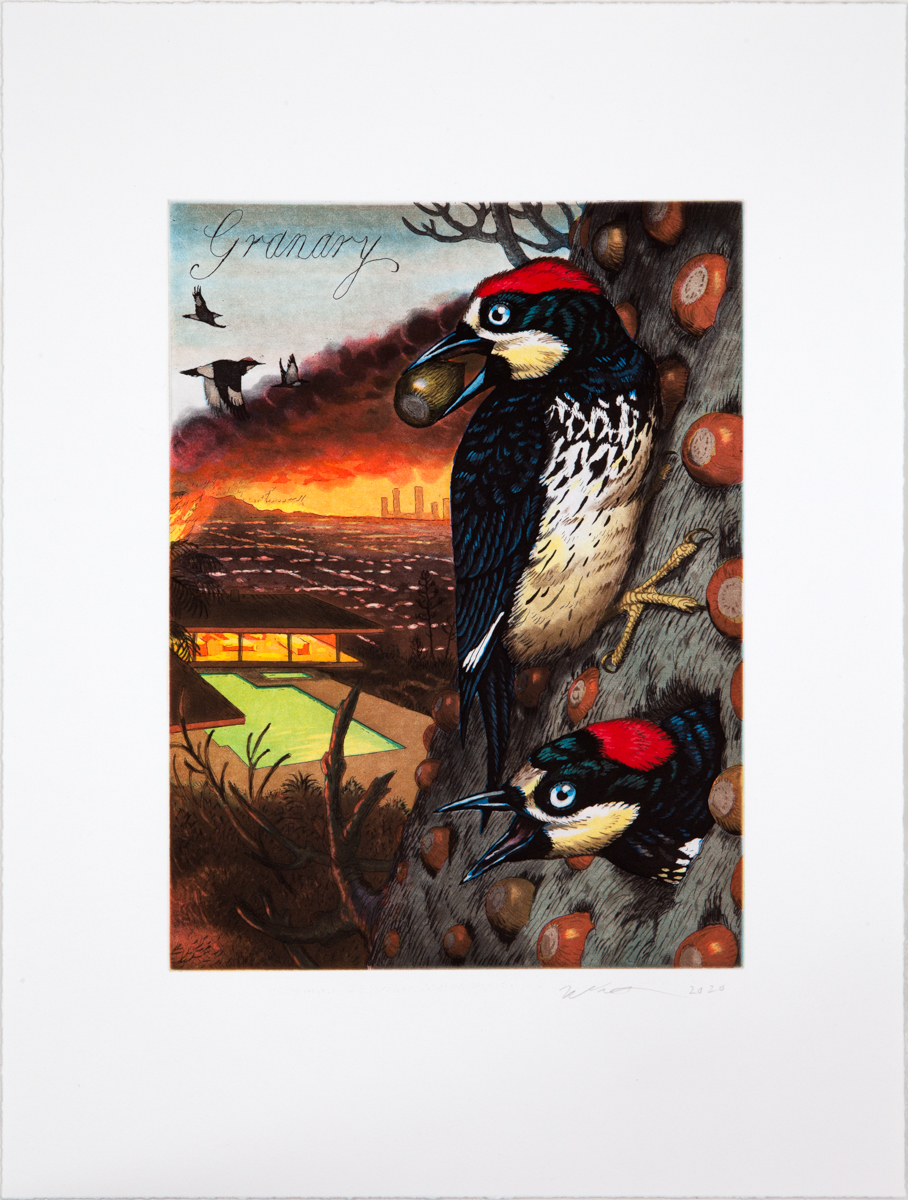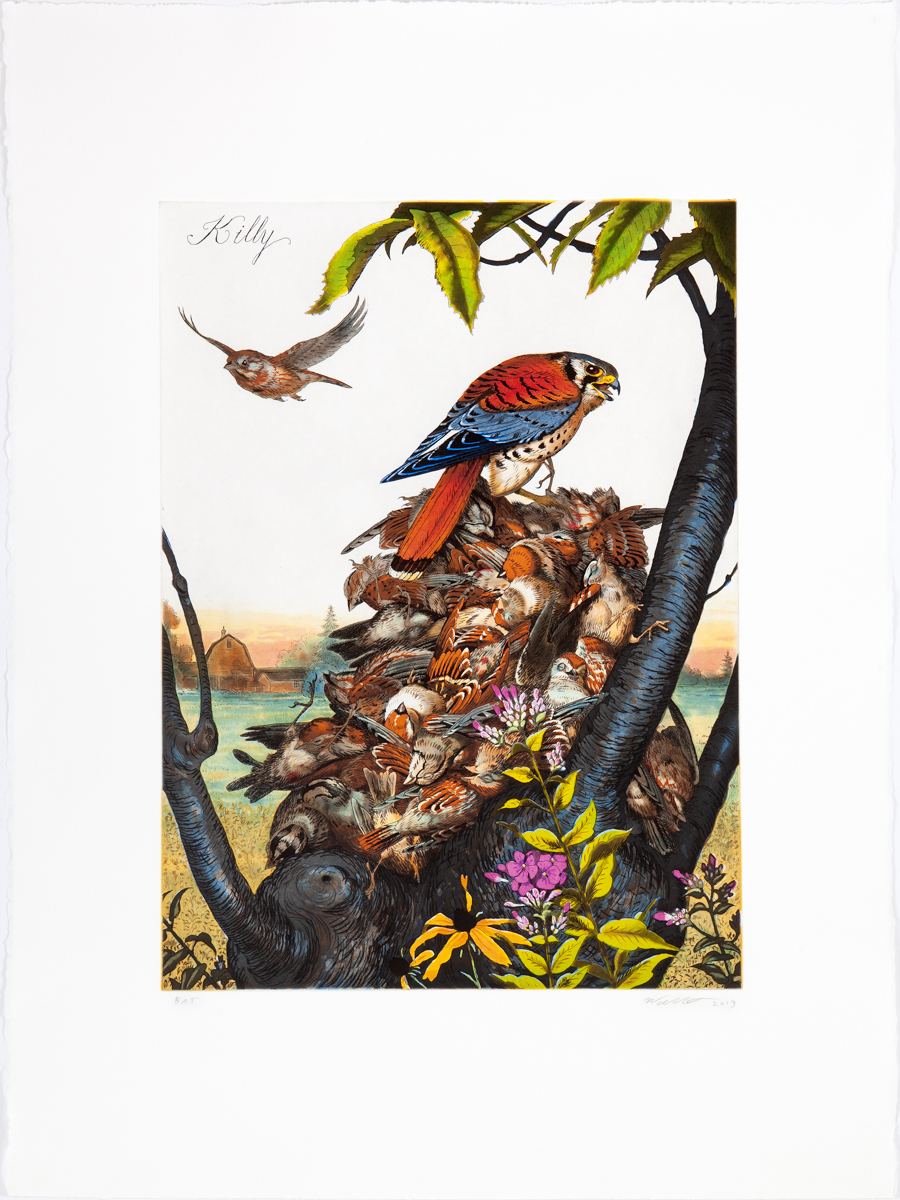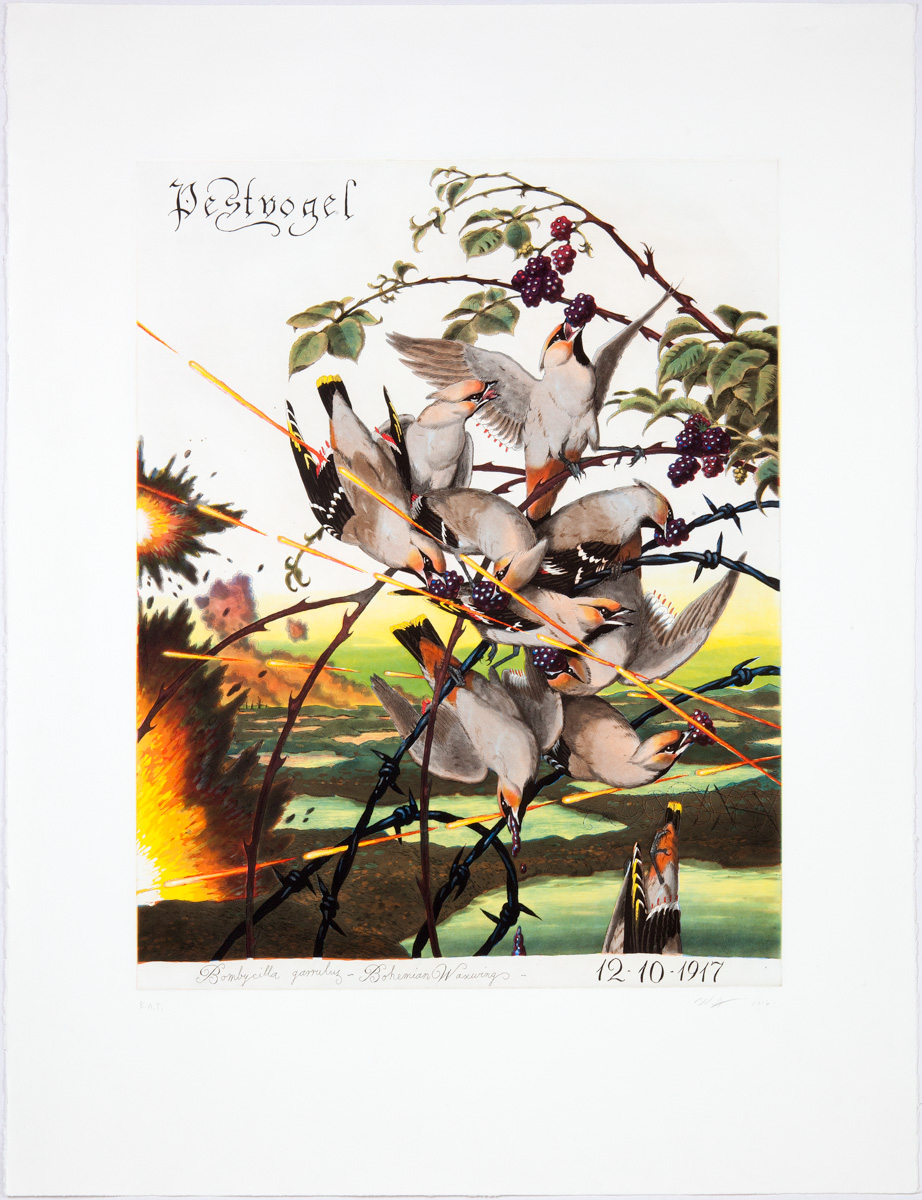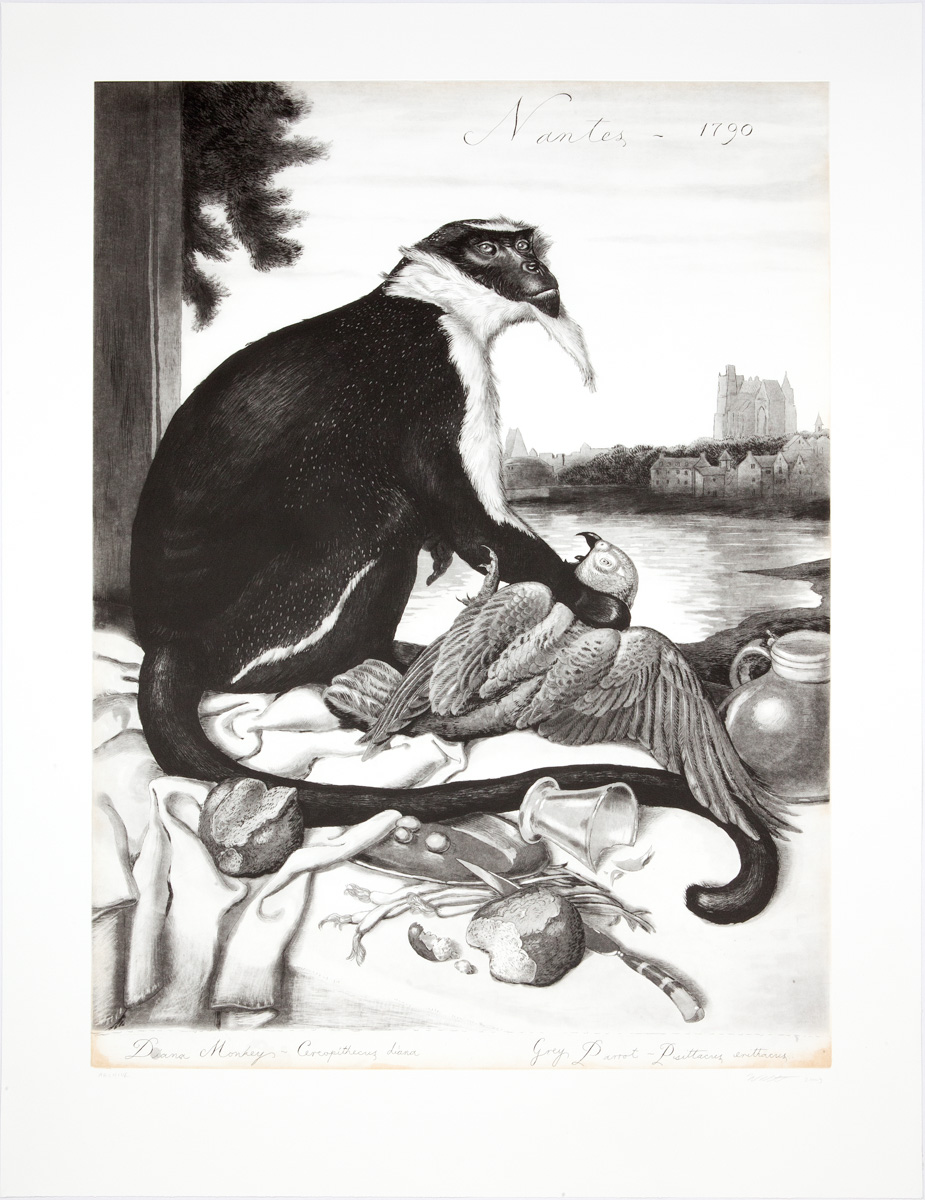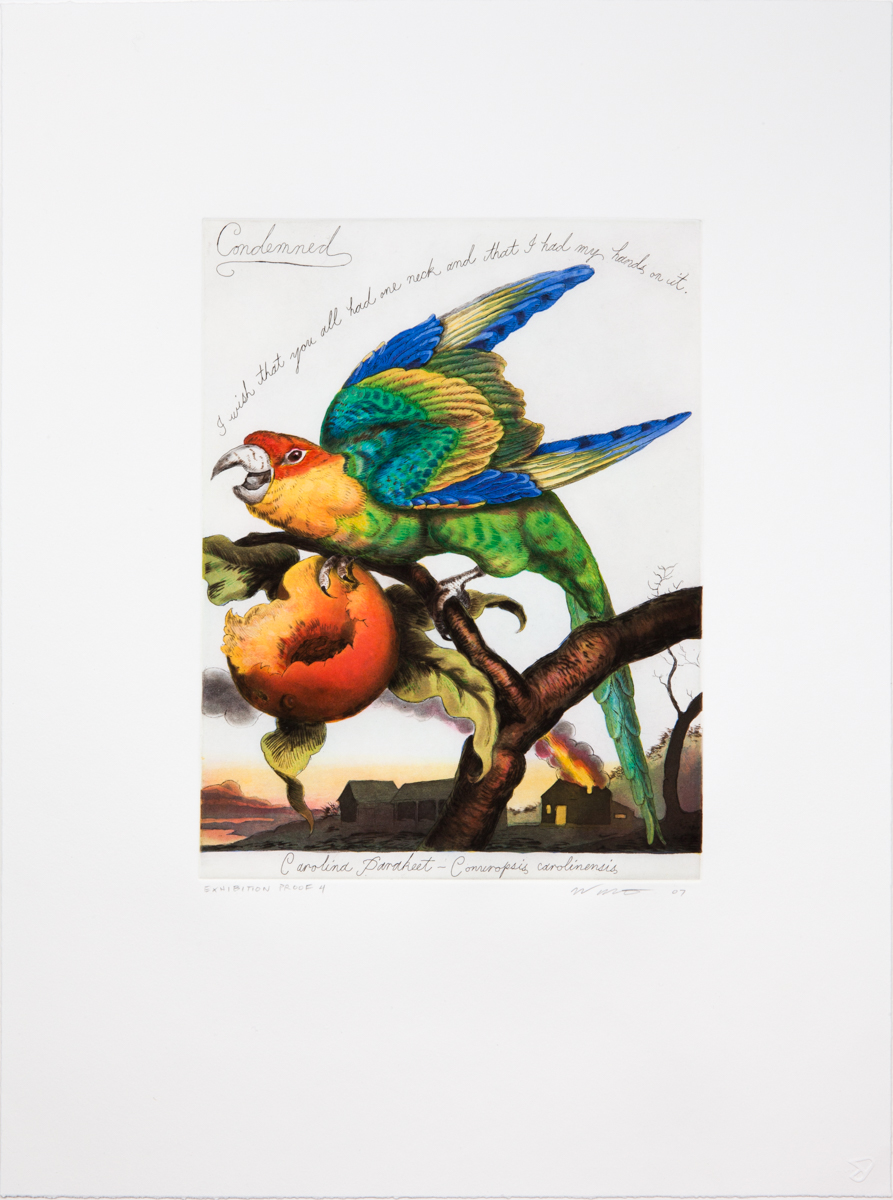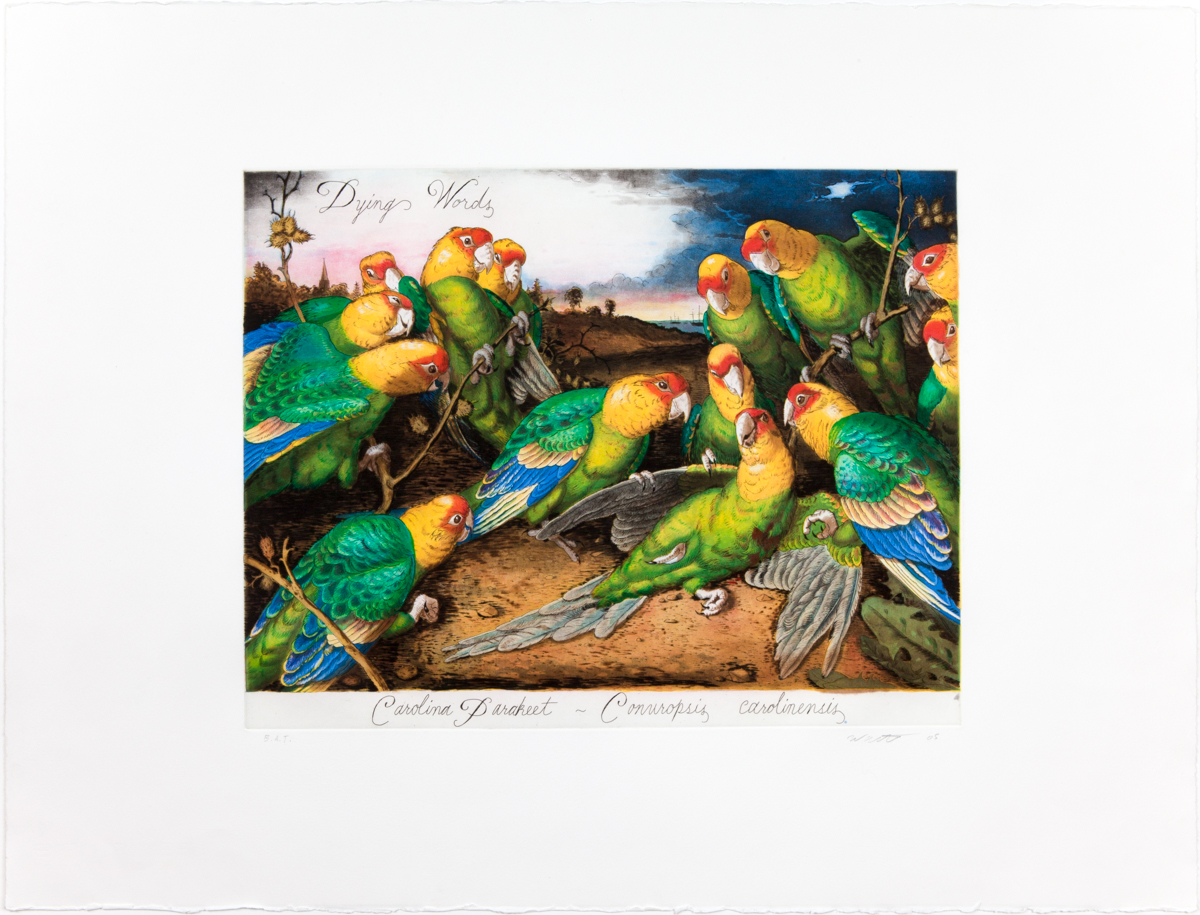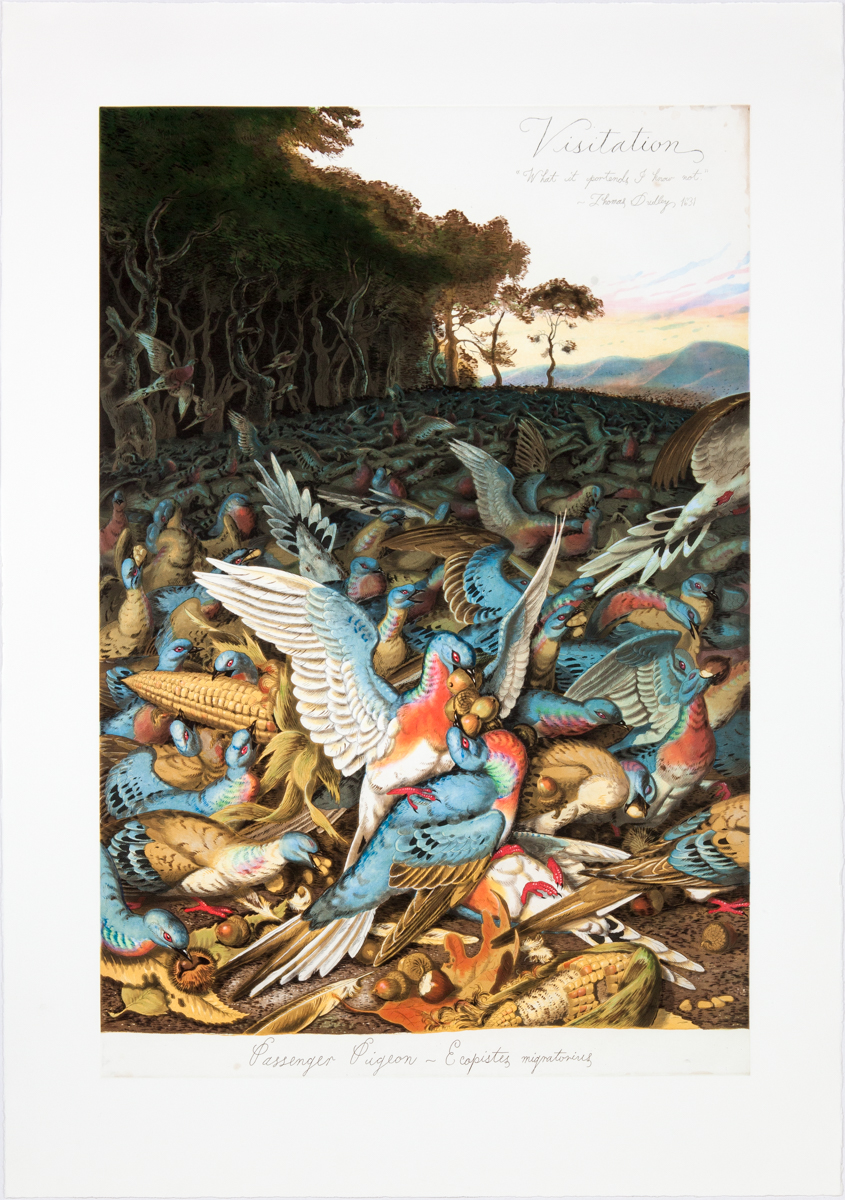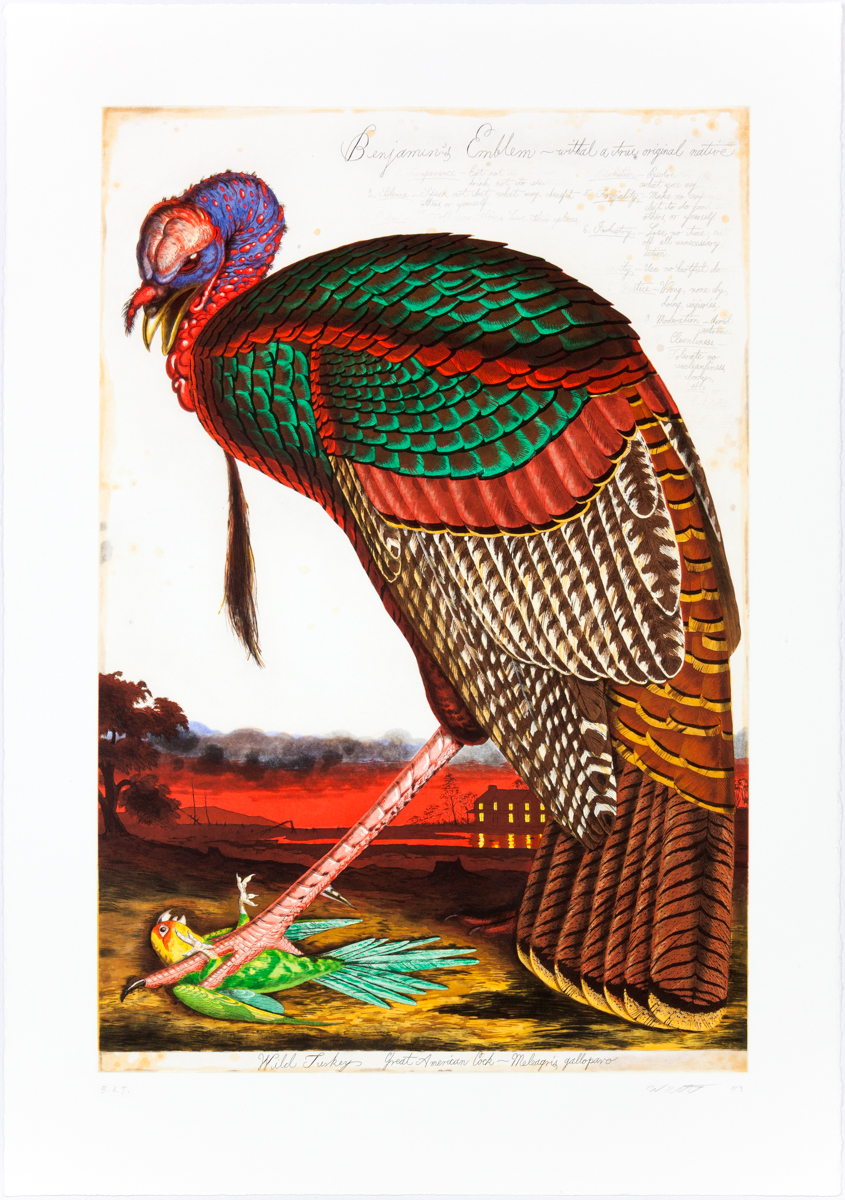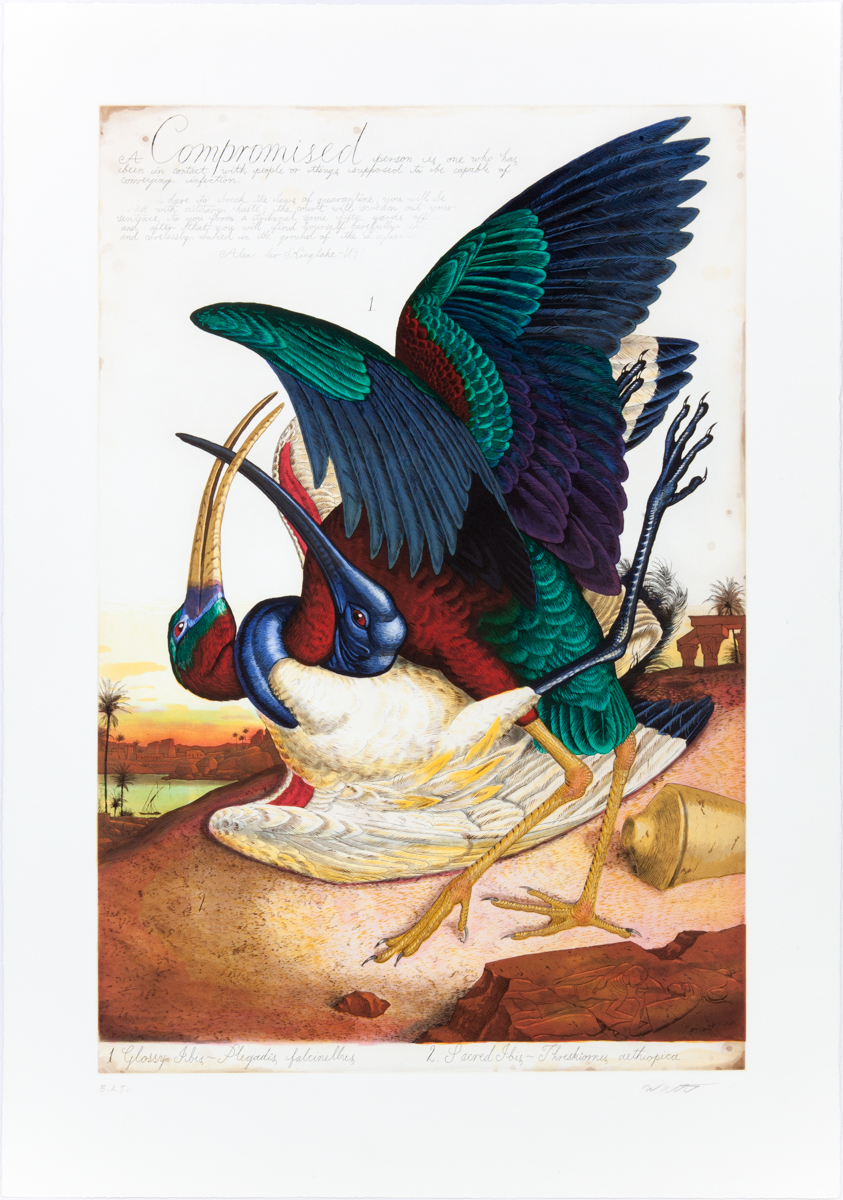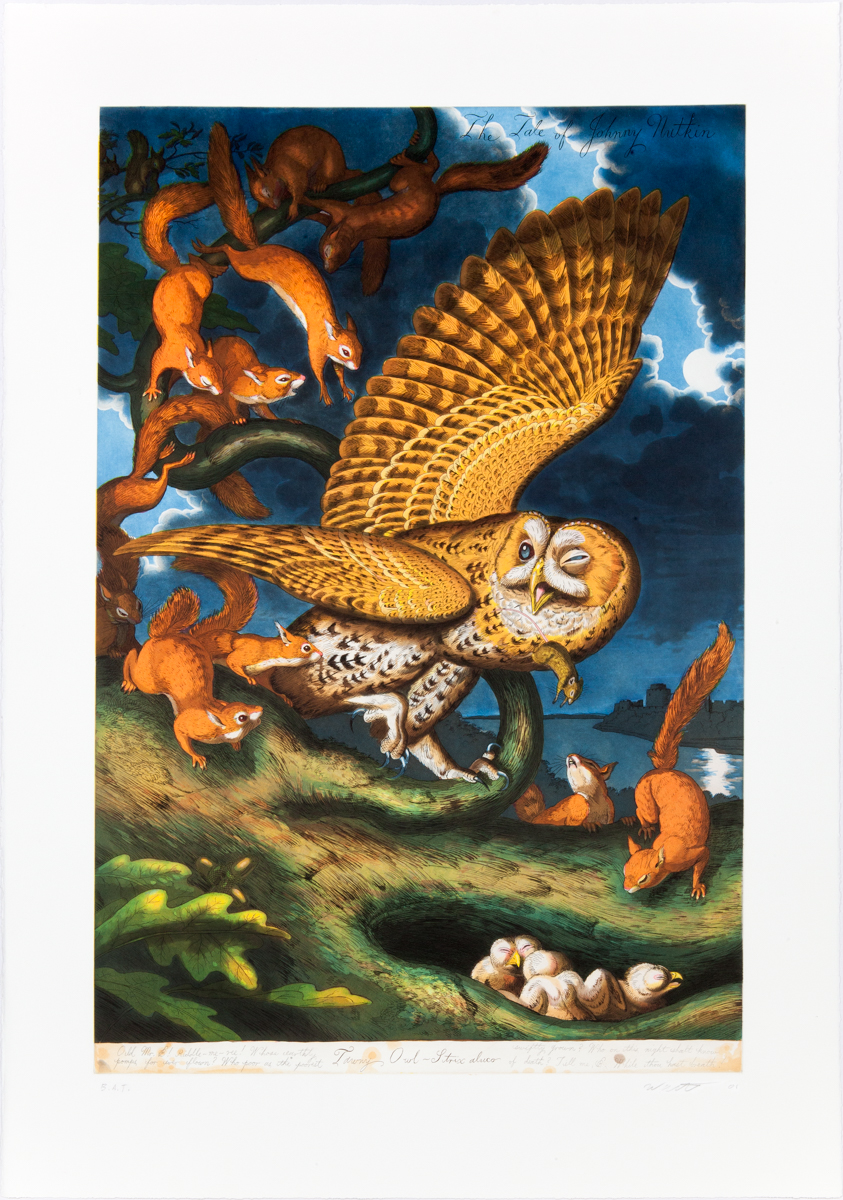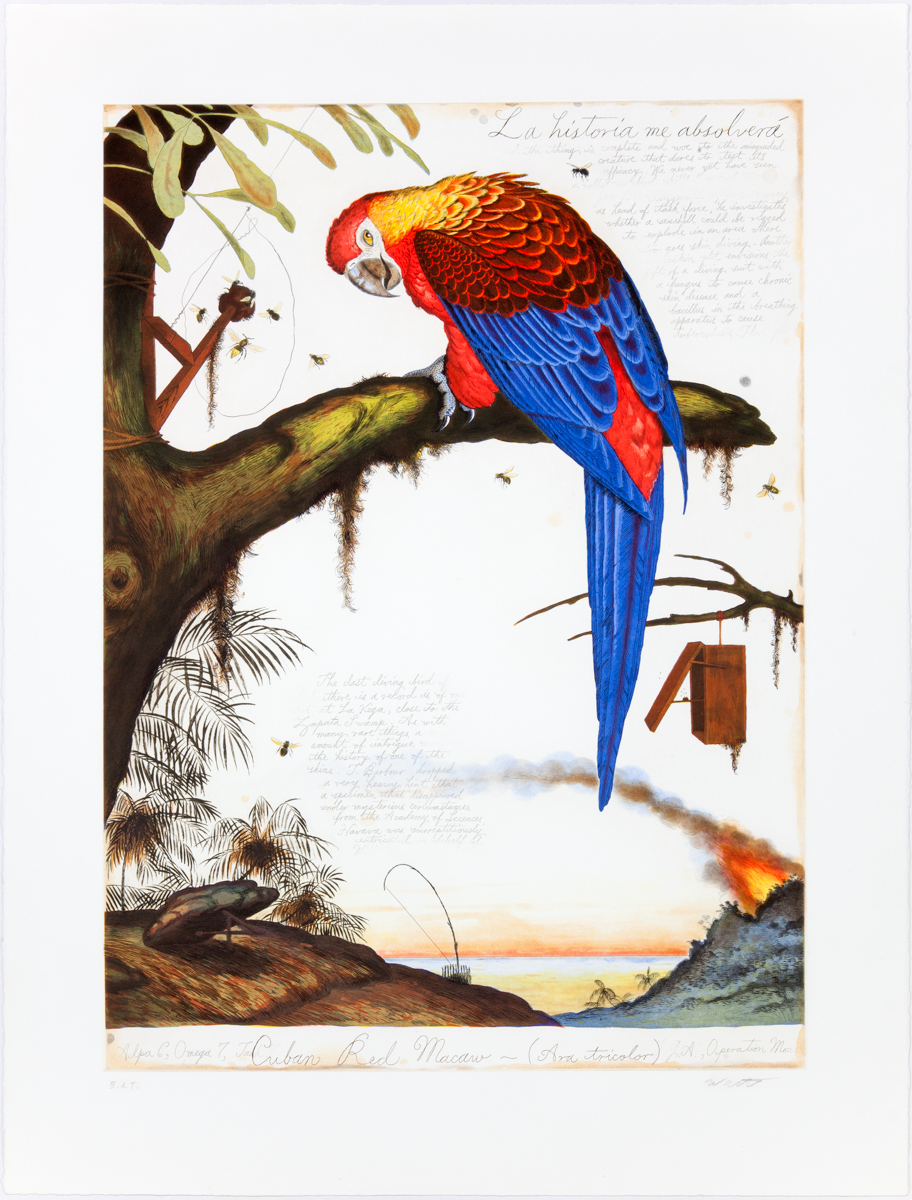Walton Ford
Six plate aquatint etching with dry point, hard ground and spit bite on white Rives BFK paper
Signed, dated and numbered by the artist on recto
Plate size: 12 x 9 inches
Paper size: 18.5 x 14 inches
Edition of 100
Published by TASCHEN
Printed by Wingate Studio
Working with master printers Peter Pettengill and James Pettengill at Wingate Studio, Ford used the traditional techniques of line etching, hard and soft ground, aquatint, spit bite, sugar lift, and drypoint to create this print. Granary is a follow-up to Ford’s Calafia series, in which the artist explores California’s myth, folklore, and cinematic history. The print depicts crimson-capped Acorn Woodpeckers guarding their cache of acorns as the Hollywood Hills—and the famed Stahl House—are threatened by wildfire. The thrifty avians are tolerant of humans and can store up to 60,000 acorns in a single hoard, even using telephone poles and fence posts to house their provisions.
At first glance, Ford’s large-scale, highly detailed watercolors and etchings of animals recall the prints of 19th-century illustrators John James Audubon and Edward Lear. A closer look reveals a complex and disturbingly anthropomorphic universe, full of symbols, sly jokes, and allusions to the ‘operatic’ quality of traditional natural history.
In this stunning but sinister visual universe, beasts and birds are not mere aesthetic objects but dynamic actors in allegorical struggles: a wild turkey crushes a small parrot in its claw; a troupe of monkeys wreaks havoc on a formal dinner table; an American buffalo is surrounded by bloodied white wolves. In dazzling watercolor, the images impress as much for their impeccable realism as they do for their complex narratives.
Granary, an edition of 100, was printed by hand on 100% cotton archival-quality Rives BFK paper, using a French-made Le Deuil etching press. Each print is numbered and signed by the artist.
In the studio
Six plate aquatint etching with dry point, hard ground and spit bite on white Rives BFK paper
Signed, dated and numbered by the artist on recto
Plate size: 20 x 15 inches
Paper size: 29.5 x 22.5 inches
Edition of 65
Published by Kasmin Gallery
Printed by Wingate Studio
The American Kestrel was formerly known throughout the United States as the Sparrow Hawk. The kestrel feeds on other birds, mice, reptiles, and insects. In 1895, Frank M. Chapman wrote in his Handbook of Birds of Eastern North America: “The Sparrow Hawk’s call is a rather high, quickly repeated killy-killy-killy-killy, which in some sections gives it the name of ‘Killy Hawk’.” (p.211)
Ford recalls a kestrel that would roost on the clothesline tower outside of his Brooklyn apartment window many years ago, and every afternoon the bird would eat an English sparrow. He noted, “I’m pretty sure that this was the bird’s only meal; that the hunt took very little effort; and that the rest of the bird’s day would be spent resting, or quietly soaring around the neighborhood. In creating this print, I got to thinking what it would be like if a sparrow hawk had the kind of greed and attachment to material things that humans have.”
Wingate Studio and Walton Ford have been working together for over 20 years. Killy, 2019, is the 14th collaborative print between the artist and Wingate Studio.
Six plate aquatint etching with hard ground, soft ground, spit bite, sugar lift, and dry point on white Somerset Satin
Signed, dated and numbered by the artist on recto
Plate size: 28 x 22 inches
Paper size: 40 x 30.75 inches
Edition of 65
Published by Kasmin Gallery
Printed by Wingate Studio
The print depicts a small flock of Bohemian waxwings gorging on blackberries as a battle rages in the background. Waxwings are fruit-eating Eurasian perching birds. “Periodically waxwings break out from their boreal confines and undertake massive, sometimes continent- wide migrations…Such was the impact of these sudden, inexplicable arrivals that Bohemian Waxwings were once loaded with sinister import…Old names for the species included Pestvogel (‘plague-bird’) which is still the bird’s name in Dutch, as well as unglückvogel, pestilenzvogel, and todtenvogel in German-speaking areas (respectively, ‘disaster-bird’, ‘pestilence-bird’ and ‘death bird’). A widely recorded waxwing invasion during the winter of 1913/14 was later assumed to be a foreboding omen for the calamity that ensued the following summer – the First World War” (Cocker, Mark. Birds and People. London: Jonathan Cape, 2013, p 407).
Such violent and bizarre moments at the intersection of human culture and the natural world are the subject of much of Ford’s work. To quote the artist, “In this print I imagined what
kind of imagery could accompany this fantastic belief, the idea that a small songbird could be responsible for a world war. Some of my work is a literal exploration in these kinds of fears and superstitions.”
Wingate Studio is based in the Connecticut River Valley, and under directors Peter Pettengill, James Pettengill, and Alyssa Robb, the Studio produces and publishes printed editions, books, and special projects with contemporary artists. Peter Pettengill and Walton Ford have been working together for nearly 20 years.
Two plate aquatint etching with dry point, hard ground, and spit bite on white Somerset Satin paper
Signed, dated and numbered by the artist on recto
Plate size: 40 x 30 inches
Paper size: 48 x 37 inches
Edition of 65
Published by Kasmin Gallery
Printed by Wingate Studio
Six plate aquatint etching with dry point, hard ground, soft ground, spit bite and sugar lift on white Rives BFK paper
Signed, dated and numbered by the artist on recto
Plate size: 12 x 9 inches
Paper size: 18.5 x 14 inches
Edition of 100
Published by TASCHEN
Printed by Wingate Studio
Six plate aquatint etching with dry point, hard ground, soft ground, spit bite and sugar lift on white Rives BFK paper
Signed, dated and numbered by the artist on recto
Plate size: 12 x 9 inches
Paper size: 21.5 x 16 inches
Edition of 75
Published by Kasmin Gallery
Printed by Wingate Studio
Six plate aquatint etching with dry point, hard ground, soft ground, spit bite and sugar lift on white Rives BFK paper
Signed, dated and numbered by the artist on recto
Plate size: 12 x 9 inches
Paper size: 21.5 x 16 inches
Edition of 75
Published by Kasmin Gallery
Printed by Wingate Studio
Sold Out
Six plate aquatint etching with dry point, hard ground, soft ground, spit bite and sugar lift on white Somerset satin paper
Signed, dated and numbered by the artist on recto
Plate size 14 x 18 inches
Paper size 22.5 x 30 inches
Edition of 75
Published by Kasmin Gallery
Printed by Wingate Studio
Six plate aquatint etching with dry point, hard ground, soft ground, spit bite and sugar lift on white Somerset Satin paper
Signed, dated and numbered by the artist on recto
Plate size: 36 x 24 inches
Paper size 44 x 31 inches
Edition of 50
Published by Blue Heron Press
Printed by Wingate Studio
Six plate aquatint etching with dry point, hard ground, soft ground, spit bite and sugar lift on white Somerset Satin paper
Signed, dated and numbered by the artist on recto
Plate size 36 x 24 inches
Paper size 44 x 31 inches
Edition of 50
Published by Blue Heron Press
Printed by Wingate Studio
Six plate aquatint etching with dry point, hard ground, soft ground, spit bite and sugar lift on white Somerset Satin paper
Signed, dated and numbered by the artist on recto
Plate size: 36 x 24 inches
Paper size: 44 x 31 inches
Edition of 50
Published by Blue Heron Press
Printed by Wingate Studio
Six plate aquatint etching with dry point, hard ground, soft ground, spit bite and sugar lift on white Somerset Satin paper
Signed, dated and numbered by the artist on recto
Plate size: 36 x 24 inches
Paper size: 44 x 31 inches
Edition of 50
Published by Blue Heron Press
Printed by Wingate Studio
Six plate aquatint etching with dry point, hard ground, soft ground, spit bite and sugar lift on white Somerset Satin paper
Signed, dated and numbered by the artist on recto
Plate size: 36 x 24 inches
Paper size: 44 x 31 inches
Edition of 50
Published by Blue Heron Press
Printed by Wingate Studio
Six plate aquatint etching with dry point, hard ground, soft ground, spit bite and sugar lift on white Somerset Satin paper
Signed, dated and numbered by the artist on recto
Plate size: 36 x 24 inches
Paper size: 44 x 31 inches, edition of 50
Sold Out
Published by Blue Heron Press
Printed by Wingate Studio
About the artist
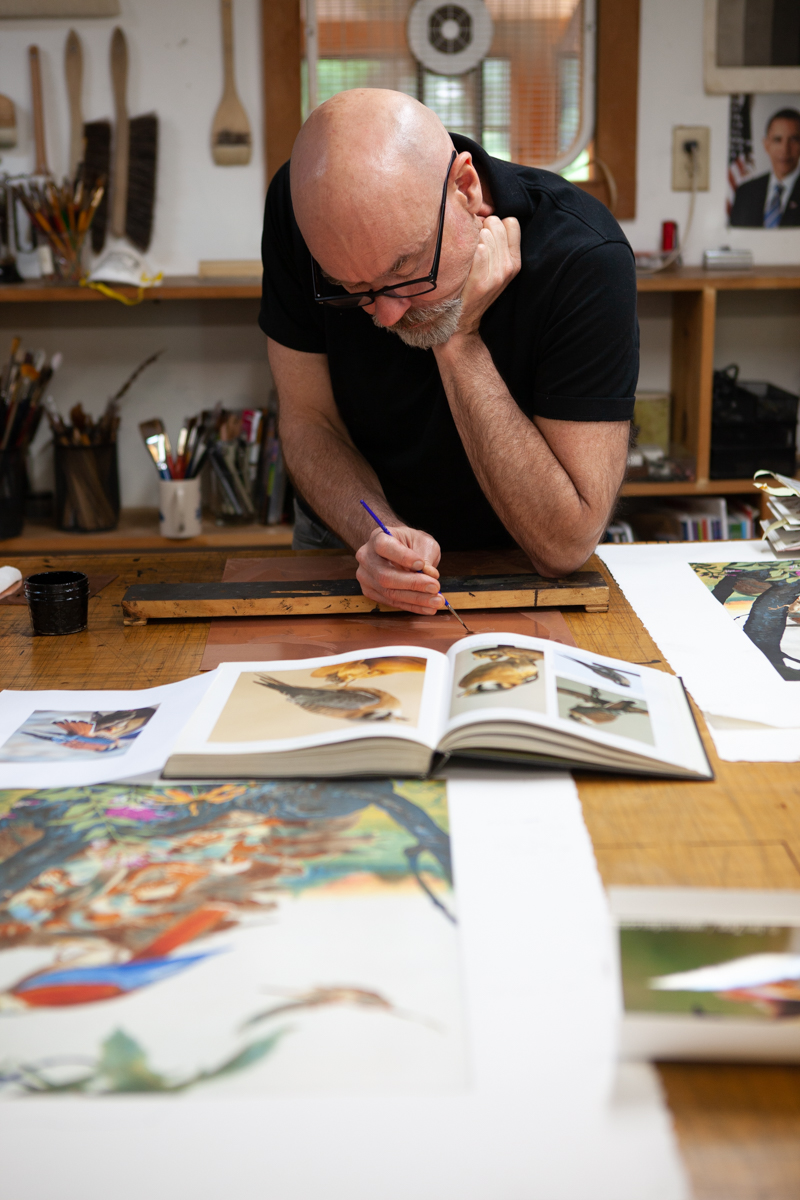
Photography by Alyssa Robb for Wingate Studio
